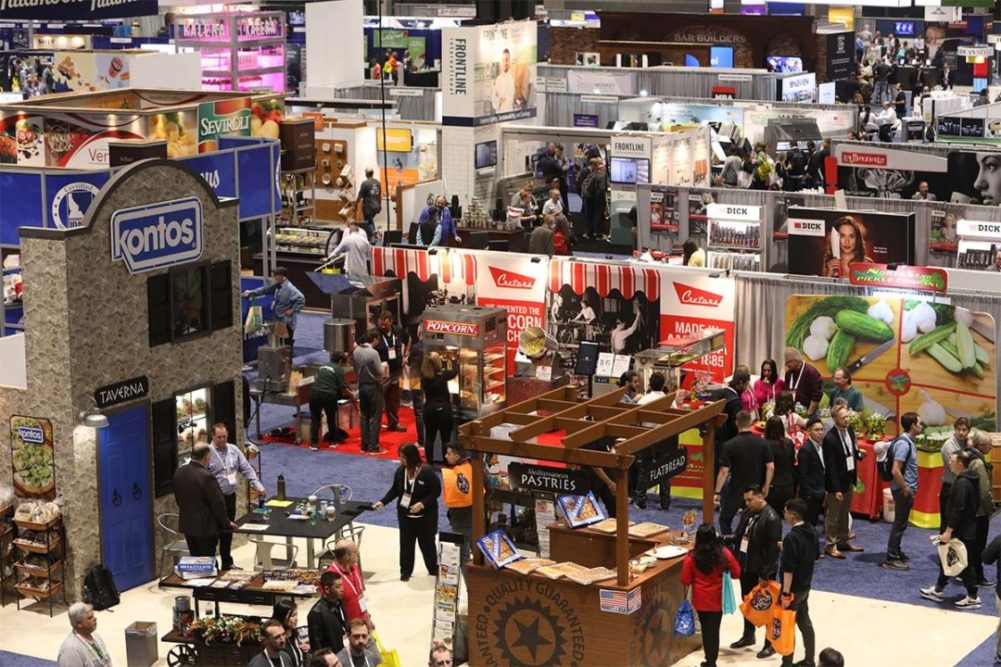Foodservice food and beverage suppliers showcased the latest innovations at the National Restaurant Show held in Chicago May 21-24. Scattered among long-established Windy City brands, such as Vienna Beef, Eli’s Cheesecake and Grecian Delight, were restaurant operators from around the world sampling products that speak to consumer trends and at the same time ease the struggles the industry is facing in terms of labor, supply chains and economics.
“There’s amazing food all over the world and we have barely scratched the surface,” said Zia Ahmed, senior director, dining services, The Ohio State University, Columbus, Ohio, during a session on food trends.
In terms of menu innovation, Dave Henkes, senior principal, and Lizzy Freier, menu research and insights, both with Chicago-based Technomic, discussed how to “drive business and delight guests” using their five “Ps.” The first “p” is to pivot. This involves rethinking the menu without adding too many new ingredients. One approach is to infuse dishes with new flavors or creating mashups that “combine the known and the unknown,” Freier said.
The average number of items on restaurant menus has been declining for the past several years, with COVID-19 forcing restaurants to streamline offerings to focus on items that drive revenue and work best for takeout and delivery, Henkes said. At the same time, limited-time offerings have been growing.
“Restaurants are trying to do more with less,” Henkes added. “This gives consumers something to be excited about.”
For operators, this may be accomplished by adding new flavors to a basic recipe. Suppliers on the expo floor showcased shortcuts to assist.
MegaMax Foods, a business of Hormel Foods Corp., Austin, Minn., for example, debuted Tres Cocinas pepper pastes. The concentrated pastes come in three profiles and are formulated to assist chefs with adding authentic flavor to Mexican cuisine. The ancho and pasilla variety features hints of dark chocolate and dried fruit. The chipotle pepper paste includes adobo sauce for a balance of smoke and heat. The third offering is made with guajillo peppers and spices and provides a balanced, slightly sweet flavor with hints of berries.
Preparing for the best
The second “p,” according to Technomic, is preparation. Persistent supply chain woes are forcing operators to innovate with unique and varied preparations of ingredients on hand, Henkes said. This includes everything from freezing a cocktail that’s usually served on the rocks to give it a slushy texture to charring vegetables to give them a deeper flavor.
“Sixty-six percent of consumers rate preparation styles, such as grilled, roasted or braised an appealing method of imparting flavor,” Henkes said.
Labor savers also assist with preparation. Operators looking for ways to offer flavorful and innovative menus with reduced staff may turn to products such as fully cooked chorizo crumbles and individually butcher paper-wrapped breaded spicy chicken breast Belgian-style waffle sandwiches from Tyson Foods, Springdale, Ark.
Numerous suppliers displayed labor savers in the beverage space, such as premium mixers for adult cocktails and the growing non-alcoholic mocktail category. Robots that make blended alcoholic drinks have become more sophisticated, with companies such as J&J Snack Foods Corp., Pennsauken, NJ, building on its Icee and Slush Puppie machines now offering a stream of spirits along with the fruity base mix.
Importing plant-based ideas
Plant proteins are part of the third “p.” And, it was no surprise that plant-based meat manufacturers were out in full force on the expo floor. Three first-time exhibitors came from abroad.
Israel-based Yo Foods Ltd. featured Yo!, a plant-based egg concept for operators that comes in two parts — white and yolk — enabling the preparation of sunny-side-up and poached concepts. The white is formulated with peas while the yolk is based on chickpeas and colored with carrot powder.
Next Gen Foods offers Tindle plant-based chicken created for chefs. With global headquarters in Singapore, the company has aggressive expansion plans in the United States. Tindle is a versatile, uncooked product that chefs may form into everything from patties to balls to strips. It gets its flavor from an ingredient called lipi, which is a combination of sunflower oil and natural flavors formulated to simulate chicken fat.
SavorEat, an Israeli food technology company, introduced its robot chef platform that creates a personalized plant-based burger. Using an app, the robot chef allows diners to customize their patty — protein source and fat content — and cook it in minutes.
Speaking on food trends, John Li, vice president of culinary innovation, Wendy’s, Dublin, Ohio, said health and wellness of people and the planet will continue to fuel innovation in foodservice. He cited the acronym FARM, which stands for fresh, authentic, real and minimally processed, as a mantra to follow in product development.
“If you don’t have a product from a culinary standpoint, you’re going to fail,” Li said.
When it comes to the new plant-based protein offerings on the expo floor, “every evolution is getting better,” he said.
In plant-based dairy, the big news was ice cream mix products from several companies, including Ripple Foods, Emeryville, Calif. The liquid product comes in plastic gallon milk jugs in original and vanilla flavors and can be used as soft-serve ice cream.
Tailor made
The fourth “p” is personalization, which is what you get with many of the robot concepts introduced at the show. Such robots also assist operators with labor shortages, enabling them to better focus on the dining experience.
Self-serve menu boards and sophisticated apps put the consumer in the kitchen. Such customized dishes allow diners to order something tailored to their tastes.
Technomic’s fifth “p” was its predictions going forward. Technomic predicts that a very basic ingredient — salt — will be the focal point of menu innovations. It will go beyond being a basic taste to taking center stage in cocktails and foods.
Freier cited global flavors to watch are now coming from Mesoamerica, Western Africa and Western Asia, with new peppers adding spice and nuance to dishes.

